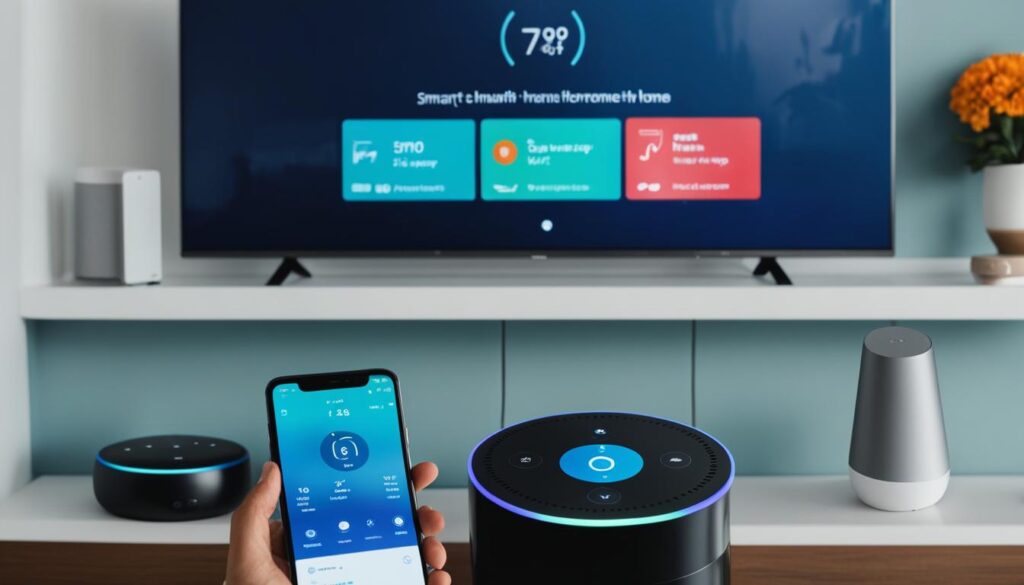Welcome to the world of smart home wireless technology! Transform your home into a connected and automated haven with the latest advancements in smart home automation.
With wireless technology for smart homes, you can enhance your living space’s security, comfort, convenience, and energy efficiency.
Smart home technology offers endless possibilities, from controlling your lighting and heating to managing your appliances remotely.
Smart home systems operate through a central home automation controller, or smart home hub, which communicates wirelessly with devices throughout your home.
Whether adjusting your thermostat on the go or controlling your kitchen appliances with a simple voice command, the power is in your hands.
With popular smart home hubs like Amazon Echo, Google Home, and Wink Hub, you can seamlessly integrate all your smart devices and easily control them through a smartphone app or other networked devices.
From smart TVs to door locks, security cameras to kitchen appliances, and everything in between, smart home technology offers a wide range of devices and appliances that can be tailored to your lifestyle.
Experience the convenience of voice control with home assistants like Amazon Alexa or Google Assistant, and enjoy the peace of mind that comes with automated security systems and energy-saving technology.
While setting up a smart home may require a reliable internet connection and careful consideration of security and data privacy, the benefits far outweigh the challenges.
As wireless technology continues to evolve, so does the potential to create a brilliant living space that integrates artificial intelligence, enhances health and wellness applications, and simplifies everyday tasks.
Contents
- 1 What is a Smart Home?
- 2 How Does Smart Home Technology Work?
- 3 Examples of Smart Home Technologies
- 4 Smart Home Pros and Cons
- 5 How to Set Up a Smart Home
- 6 Conclusion
- 7 FAQs
- 7.1 What is smart home wireless technology?
- 7.2 How does smart home technology work?
- 7.3 What are some examples of smart home technologies?
- 7.4 What are the benefits of smart home technology?
- 7.5 What are the challenges associated with smart homes?
- 7.6 How do I set up a smart home?
- 7.7 What is the future of smart home wireless technology?
- 8 Source Links
Key Takeaways:
- Smart home wireless technology enables the remote monitoring and management of appliances and systems in your home.
- Smart home systems operate through a central home automation controller, or smart home hub, which communicates wirelessly with devices.
- Popular smart home hubs include Amazon Echo, Google Home, and Wink Hub.
- Smart home devices can be controlled through smartphone apps or voice commands using home assistants like Amazon Alexa or Google Assistant.
- Smart home technology offers convenience, comfort, peace of mind, energy efficiency, and task management.
What is a Smart Home?
A smart home is a residence that utilizes internet-connected devices to enable the remote monitoring and management of appliances and systems, such as lighting and heating.
It is a technology-driven approach to modern living that offers homeowners a range of benefits, including security, comfort, convenience, and energy efficiency.
Smart home technology, also known as home automation or domotics, allows for controlling smart devices through a smartphone app or other networked device.
Also read: Discover Which Technology Shifts Your Desktop
It is part of the larger concept of the Internet of Things (IoT), which emphasizes the interconnectivity of devices and systems to streamline and optimize daily routines.
“A smart home is not just a collection of disparate smart devices and appliances, but rather a network of devices that work together through a central home automation controller, or smart home hub.”
These smart home hubs, such as Amazon Echo, Google Home, and Wink Hub, act as the central point of the system, communicating wirelessly with devices through protocols like Wi-Fi, Bluetooth, Zigbee, or Z-Wave.
The technology encompasses various aspects of life, including:
- Smart TVs: Connect to the internet to access content and may include features like voice or gesture recognition.
- Lighting systems: Can be controlled remotely and customized to adjust lighting based on occupancy and daylight availability.
- Thermostats: Allow for scheduling, monitoring, and remote control of home temperatures, optimizing comfort and energy efficiency.
- Door locks and garage door openers: Provide secure access control for homeowners and can be managed remotely.
- Security cameras and systems: Enable remote monitoring of homes with features like motion detection and notifications.
- Kitchen appliances: Offer convenience and automation features, such as coffee makers, refrigerators, and slow cookers.
- Household monitors: Sense power surges, water failures, freezing pipes, and other issues to prevent damage.
- Smart plugs: Transform regular home devices into remotely controllable devices through mobile apps and voice assistants.
Smart home technology is an innovative solution that enhances our lives, providing comfort, convenience, and security at the touch of a button or through voice commands.
The interconnected nature of smart devices and the ability to tailor their behaviors to our preferences make smart homes an increasingly popular choice for homeowners seeking a modern and efficient lifestyle.
Next, we will explore how smart home technology works and the key components that make it all possible.
How Does Smart Home Technology Work?
Smart home technology operates through a central home automation controller, a smart home hub. This hardware device serves as the main point of the smart home system, enabling wireless sensing, processing, and communication of data.
By consolidating all apps and devices into a single, smart home app, homeowners can conveniently control their homes remotely using smartphones or other networked devices.
While Wi-Fi and Bluetooth are commonly used for connectivity in smart home products, wireless protocols like Zigbee or Z-Wave are also utilized.
The smart home hub communicates with various devices, such as lights, thermostats, security systems, and appliances, all controlled by the seat.
Also read: What is Ampak Technology on My Wi-Fi?
Smart home devices can be programmed to follow specific schedules or commands or respond to voice commands via popular home assistants like Amazon Alexa or Google Assistant.
For example, a smart thermostat can learn the homeowner’s habits and automatically adjust the temperature based on their schedule.
The wireless connectivity of smart home technology enables seamless integration and control of diverse devices and systems within the home.

| Wireless Technology | Description |
|---|---|
| Wi-Fi | It provides high-speed wireless connectivity and is widely used in smart home devices. |
| Bluetooth | It enables short-range wireless communication between devices and is commonly used for connecting peripherals. |
| Zigbee | Operates on a mesh network topology, allowing devices to communicate with each other and extend the range of the network. |
| Z-Wave | Works on a low-power mesh network, providing reliable communication between devices with an excellent range and robust security features. |
Smart home technology relies on these wireless technologies to connect and control devices, enhancing the convenience and functionality of the smart home system.
Examples of Smart Home Technologies
Smart home technology has transformed how we interact with our homes, offering innovative alternatives to traditional devices and appliances.
These technologies empower homeowners to create efficient, convenient, and secure living environments. Here are some examples of smart home technologies:
1. Smart TVs
Smart TVs are internet-connected televisions that provide access to a wide range of content through applications. They often come with features like voice or gesture recognition, allowing users to control their TVs using voice commands or hand movements.
2. Smart Lighting Systems
Intelligent lighting systems allow users to control and customize their lighting remotely. These systems can adjust lighting based on occupancy and daylight availability, enhancing energy efficiency and creating personalized lighting experiences.
3. Smart Thermostats
Smart thermostats like the famous Google Nest feature integrated Wi-Fi and advanced temperature control capabilities.
These thermostats can be programmed, monitored, and controlled remotely, ensuring optimal comfort and energy efficiency. They can even learn the homeowner’s habits and automatically adjust settings accordingly.
4. Smart Door Locks
Bright door locks offer enhanced security and convenience. Homeowners can remotely control and manage home access, providing secure entry for family members, guests, and service providers.
Intelligent door locks can be controlled through smartphone apps or integrated into larger smart home systems.
5. Smart Security Cameras
Smart security cameras and systems provide homeowners with peace of mind and remote monitoring capabilities.
These cameras can detect suspicious activities, send notifications to homeowners or authorities, and provide real-time video feeds through smartphone apps or web interfaces.
6. Smart Pet and Lawn Care
Intelligent pet and lawn care devices automate daily tasks, such as feeding pets and watering lawns.
Connected timers and sensors ensure that pets are fed on schedule and lawns are adequately watered, promoting both pets’ and outdoor spaces’ health and well-being.
7. Smart Kitchen Appliances
Smart kitchen appliances offer convenience and automation features that simplify daily tasks.
Coffee makers, refrigerators, and slow cookers can be connected to mobile apps or voice assistants, enabling users to remotely control and monitor these appliances.
8. Smart Household Monitors
Household monitors provide real-time monitoring of various systems within the home, such as power usage, water failures, and freezing pipes.
These monitors can detect issues and alert homeowners, helping prevent potential damage or emergencies.
9. Smart Plugs
Smart plugs allow homeowners to transform regular home devices, like lamps and fans, into remotely controllable devices. Users can turn devices on or off through mobile apps or voice assistants, set schedules, and monitor energy usage.
These examples highlight the wide range of possibilities offered by smart home technologies. With increasing integration and compatibility, homeowners can create personalized and connected living spaces that enhance comfort, efficiency, and security.

Smart Home Pros and Cons
Smart home technology offers numerous advantages and benefits to homeowners. It ensures security by allowing remote monitoring of homes and countering dangers like forgotten appliances or unlocked doors.
It accommodates user preferences for convenience by automating various tasks upon arrival or departure. Smart home technology offers peace of mind regarding the safety and well-being of family members, especially for seniors who can be remotely monitored.
It improves efficiency by optimizing energy usage, reducing utility bills, and saving resources. Smart homes can manage tasks through voice assistants, accomplish various tasks through speech recognition and voice commands, and control household smart devices.
However, there are also some disadvantages and concerns associated with smart homes. They require a reliable internet connection, as an outage can render devices and gadgets inoperable.
Some people may find the technology complex or overwhelming, but efforts are being made to reduce complexity and improve the user experience.
A lack of standards can limit device interoperability from different manufacturers, but standard alliances are working to ensure compatibility.
Security and data privacy are also concerns, as many smart devices lack built-in encryption and can be vulnerable to hackers. The collection and use of consumer data by smart home device manufacturers raise concerns about data privacy and unauthorized access.
Lastly, smart home technology can be expensive, although prices are coming down, and the cost can vary depending on the extent of integration and automation.
Overall, smart home technology offers a range of benefits while also presenting some challenges. By considering these pros and cons, homeowners can make informed decisions about integrating smart home devices into their lives.
How to Set Up a Smart Home
Setting up a smart home is an exciting journey that brings convenience, comfort, and efficiency to your everyday life.
Whether building a new home or retrofitting your existing one, wireless technologies are crucial in creating a seamless smart home experience.
This section explores various wireless technologies, such as Zigbee, Z-Wave, Matter, and even Raspberry Pi, that can help you set up your dream smart home.
Wireless Technologies for Smart Homes
and Z-Wave are two commonly used options for wireless communication protocols in home automation that operate on a mesh network topology, allowing devices to communicate with each other and extend the range of the network.
It is known for its low power consumption, making it perfect for battery-powered devices. On the other hand, Z-Wave operates on a low-power mesh network and provides reliable communication between devices. It offers an excellent range and robust security features.
Recently, a new smart home standard called Matter was introduced. Launched in November 2022, Matter is gaining momentum and is supported by major smart home manufacturers.
Its goal is to solve compatibility challenges by providing a framework for seamless communication across devices, apps, and cloud services. This standard aims to simplify the setup process and ensure interoperability between different smart home devices.
Creating Your Smart Home System
Now that you know about the wireless technologies available, you have two options for setting up your smart home system. You can create your design using prototyping boards like Raspberry Pi or bundled smart home kits.
If you enjoy tinkering with technology, building your smart home system with a prototyping board like Raspberry Pi can be a fun and rewarding experience.
Raspberry Pi is a credit card-sized computer that allows you to customize your smart home setup according to your specific needs and preferences.
It lets you connect and control various devices, sensors, and actuators, making it a versatile platform for DIY smart home projects.
On the other hand, if you prefer a more streamlined approach, bundled smart home kits provide a convenient solution. These kits include smart devices and components to set up your smart home system.
They often come with a smart home hub, bulbs, plugs, and other devices easily integrated and controlled through a mobile app or voice assistant.
Below is a table comparing the pros and cons of building a smart home system with Raspberry Pi and using bundled smart home kits:
| Option | Pros | Cons |
|---|---|---|
| Raspberry Pi |
|
|
| Bundled Smart Home Kits |
|
|

In conclusion, setting up a smart home is an exciting endeavor that requires careful consideration of the wireless technologies available. Zigbee, Z-Wave, and the emerging Matter standard offer reliable and secure communication options for smart home devices.
Whether you build your smart home system using Raspberry Pi or opt for bundled smart home kits, the choice ultimately depends on your preferences, technical expertise, and desire for customization.
Whichever path you take, embracing the possibilities of home automation will enhance your living experience and bring you one step closer to the future of intelligent living.
Conclusion
Smart home wireless technology has revolutionized how we interact with our homes, ushering in a new era of convenience, efficiency, security, and comfort.
With the advancements in wireless technology, connectivity, and the Internet of Things (IoT), smart homes have become increasingly popular, allowing homeowners to control and manage various devices and systems remotely.
By embracing home automation and wireless devices, you can enjoy many benefits. Smart homes offer energy efficiency, allowing you to optimize your energy usage and reduce your utility bills.
They also enhance security, providing peace of mind as you can remotely monitor and control your home. Additionally, smart homes offer enhanced comfort and convenience, enabling you to automate various tasks and manage devices easily.
While there are challenges to consider, such as the need for a reliable internet connection, complexity, and security risks, the future of intelligent living is promising.
Integrating artificial intelligence, advancements in health and wellness applications, interconnectivity, energy harvesting, and the continued evolution of wireless technology will further enhance the smart home experience.
By embracing these innovations, you can transform your home into a brilliant and efficient living space.
Experience the wonders of smart home technology today and unlock the potential of wireless devices and home automation.
Step into the intelligent living world and enjoy its convenience, security, and comfort. Embrace the Internet of Things and let your home adapt to your needs, making your life easier and more enjoyable.
FAQs
What is smart home wireless technology?
Smart home wireless technology refers to internet-connected devices that enable remote monitoring and management of appliances and systems in a residence. It allows homeowners to control smart devices through a smartphone app or networked device, providing security, comfort, convenience, and energy efficiency.
How does smart home technology work?
Smart home technology works through a central home automation controller, a smart home hub. This hub communicates wirelessly with devices such as lights, thermostats, security systems, and appliances, all controlled by the corner. Smart devices can be programmed to follow schedules or respond to voice commands through home assistants like Amazon Alexa or Google Assistant.
What are some examples of smart home technologies?
Smart home technologies include smart TVs, lighting systems, thermostats, door locks and garage door openers, security cameras and systems, kitchen appliances, household monitors, and smart plugs. These devices can be seamlessly integrated into a smart home system and controlled remotely through a smartphone app or voice commands.
What are the benefits of smart home technology?
Smart home technology offers numerous advantages, including convenience, comfort, peace of mind, efficiency, resource and money savings, and task management. It allows for remote monitoring of homes, automates various tasks, optimizes energy usage, improves home security, and enhances the overall living experience.
What are the challenges associated with smart homes?
Some challenges to consider with smart homes include the need for a reliable internet connection, perceived complexity, lack of standards, security risks, and concerns about data privacy. However, efforts are being made to address these challenges and improve the user experience, such as developing standardized protocols and enhanced security measures.
How do I set up a smart home?
A smart home can be set up in newly built homes or retrofitted into older homes using wireless technologies like Wi-Fi, Zigbee, Z-Wave, and Matter. It involves the installation of a smart home hub as the central point of the system, connecting smart devices, and configuring them through a smartphone app or voice commands. Kits and prototyping boards can also create a custom smart home system.
What is the future of smart home wireless technology?
The future of smart home wireless technology involves advancements in artificial intelligence integration, health and wellness applications, interconnectivity, energy harvesting, and the continued evolution of wireless technologies. These advancements will further enhance the capabilities of smart homes and improve our quality of life.




